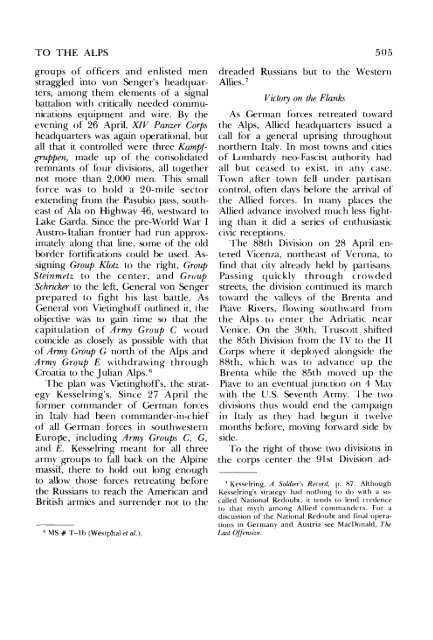Cassino to the Alps - US Army Center Of Military History
Cassino to the Alps - US Army Center Of Military History
Cassino to the Alps - US Army Center Of Military History
Create successful ePaper yourself
Turn your PDF publications into a flip-book with our unique Google optimized e-Paper software.
TO THE ALPS<br />
groups of officers and enlisted men<br />
straggled in<strong>to</strong> von Senger's headquarters,<br />
among <strong>the</strong>m elements of a signal<br />
battalion with critically needed communications<br />
equipment and wire. By <strong>the</strong><br />
evening of 26 April, XlV Panzer Corps<br />
headquarters was again operational, but<br />
all that it controlled were three Kampf<br />
gruppen, made up of <strong>the</strong> consolidated<br />
remnants of four divisions, all <strong>to</strong>ge<strong>the</strong>r<br />
not more than 2,000 men. This small<br />
force was <strong>to</strong> hold a 20-mile sec<strong>to</strong>r<br />
extending from <strong>the</strong> Pasubio pass, sou<strong>the</strong>ast<br />
of Ala on Highway 46, westward <strong>to</strong><br />
Lake Garda. Since <strong>the</strong> pre-World War I<br />
Austro-Italian frontier had run approximately<br />
along that line, some of <strong>the</strong> old<br />
border fortifications could be used. Assigning<br />
Group Klotz <strong>to</strong> <strong>the</strong> right, Group<br />
Steinmetz <strong>to</strong> <strong>the</strong> center, and Group<br />
Schricker <strong>to</strong> <strong>the</strong> left, General von Senger<br />
prepared <strong>to</strong> fight his last battle. As<br />
General von Vietinghoff outlined it, <strong>the</strong><br />
objective was <strong>to</strong> gain time so that <strong>the</strong><br />
capitulation of <strong>Army</strong> Group C woud<br />
coincide as closely as possible with that<br />
of <strong>Army</strong> Group G north of <strong>the</strong> <strong>Alps</strong> and<br />
<strong>Army</strong> Group E withdrawing through<br />
Croatia <strong>to</strong> <strong>the</strong> Julian <strong>Alps</strong>. {;<br />
The plan was Vietinghoffs, <strong>the</strong> strategy<br />
Kesselring's. Since 27 April <strong>the</strong><br />
former commander of German forces<br />
in Italy had been commander-in-chief<br />
of all German forces in southwestern<br />
Europe, including <strong>Army</strong> Groups C, G,<br />
and E. Kesselring meant for all three<br />
army groups <strong>to</strong> fall back on <strong>the</strong> Alpine<br />
massif, <strong>the</strong>re <strong>to</strong> hold out long enough<br />
<strong>to</strong> allow those forces retreating before<br />
<strong>the</strong> Russians <strong>to</strong> reach <strong>the</strong> American and<br />
British armies and surrender not <strong>to</strong> <strong>the</strong><br />
6 MS # T-lb (Westphaletal.).<br />
505<br />
dreaded Russians but <strong>to</strong> <strong>the</strong> Western<br />
Allies. 7<br />
Vic<strong>to</strong>ry on <strong>the</strong> Flanks<br />
As German forces retreated <strong>to</strong>ward<br />
<strong>the</strong> <strong>Alps</strong>, Allied headquarters issued a<br />
call for a general uprising throughout<br />
nor<strong>the</strong>rn Italy. In most <strong>to</strong>wns and cities<br />
of Lombardy neo-Fascist authority had<br />
all but ceased <strong>to</strong> exist, in any case.<br />
Town after <strong>to</strong>wn fell under partisan<br />
control, often days before <strong>the</strong> arrival of<br />
<strong>the</strong> Allied forces. In many places <strong>the</strong><br />
Allied advance involved much less fighting<br />
than it did a series of enthusiastic<br />
civic receptions.<br />
The 88th Division on 28 April entered<br />
Vicenza, nor<strong>the</strong>ast of Verona, <strong>to</strong><br />
find that city already held by partisans.<br />
Passing quickly through crowded<br />
streets, <strong>the</strong> division continued its march<br />
<strong>to</strong>ward <strong>the</strong> valleys of <strong>the</strong> Brenta and<br />
Piave Rivers, flowing southward h'om<br />
<strong>the</strong> <strong>Alps</strong> <strong>to</strong> enter <strong>the</strong> Adriatic near<br />
Venice. On <strong>the</strong> 30th, Truscott shifted<br />
<strong>the</strong> 85th Division fium <strong>the</strong> IV <strong>to</strong> <strong>the</strong> II<br />
Corps where it deployed alongside <strong>the</strong><br />
88th, which was <strong>to</strong> advance up <strong>the</strong><br />
Brenta while <strong>the</strong> 85th moved up <strong>the</strong><br />
Piave <strong>to</strong> an eventual junction on 4 May<br />
with <strong>the</strong> U.S. Seventh <strong>Army</strong>. The two<br />
divisions thus would end <strong>the</strong> campaign<br />
in Italy as <strong>the</strong>y had begun it twelve<br />
months before, moving fe:mvard side by<br />
side.<br />
To <strong>the</strong> right of those two divisions in<br />
<strong>the</strong> corps center <strong>the</strong> 91 st Division ad-<br />
7 Kesselring, A Soldier's Record, p. 87. Although<br />
Kesselring's strategy had nothing <strong>to</strong> do with a socalled<br />
National Redoubt, it tends <strong>to</strong> lend credence<br />
<strong>to</strong> that myth among Allied commanders. For a<br />
discussion of <strong>the</strong> National Redoubt and final operations<br />
in Germany and Austria see MacDonald, The<br />
Last <strong>Of</strong>fensive.
















